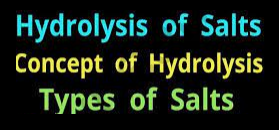Table of Contents
Hydrolysis Salts: Salts are powerful electrolytes that fully ionise to create ions. These ions can create conjugate pairs when they combine with water. The cation or anion may undergo hydrolysis, resulting in an increase in hydrogen or hydroxide ion concentrations, making the solution acidic, basic, or neutral, depending on the strength of the pairs. As a result, it is the polar opposite of the neutralization reaction. Hydrolysis does not occur in a strong acid or base’s salt. As a result, sodium sulphate will not be hydrolyzed in water.
When salt ions react with water, they can form either weak acid, weak base, or both. As a result, the pH of a solution may fall below or exceed 7. In this article, learn about salt hydrolysis, the hydrolysis constant, and how to tell if salt is basic, acidic, or neutral.
Salt Types Determined by Hydrolysis
Based on their hydrolytic behaviour, salts are divided into four categories. They are.
- Strong acid and strong base salts
- Salts of a strong acid and a weak acid
- Strong acid and weak base salts
- A weak acid and a weak base’s salts
Strong Acid and Strong Base Salts
These salts are incapable of hydrolysis. The cations of strong bases and anions of strong acids are easily hydrated in aqueous solutions. Still, they do not hydrolyze, resulting in neutral solutions of salts generated from strong acids and bases.
Salt of Strong Acid and Weak Base
Because the salt’s cation is reactive, and this form of salt undergoes cationic hydrolysis from a weak base, and H+ ions, the aqueous solutions of this type of salt are acidic. NH4Cl, CuSO4, Ca(OH)2, and other salts are examples.
The Salt of a Strong Base and a Weak Acid
The aqueous solutions of these salts are basic because the anion reacts, and the salt undergoes anionic hydrolysis to produce weak acid and OH– ions. Examples include CH3COONa, Na2CO3, and other related molecules.
Weak Acid and Weak Base Salts
Because both the cation and anion are reactive and react with water to form H+ and OH– ions, this type of salt requires maximum hydrolysis.

FAQ’s
Question: What are the different types of salts that are hydrolyzed?
Answer: Based on their hydrolytic behaviour, salts are divided into four classes. In reality, they are.
- A salt that consists of mild acid and a strong base.
- Strong acid and weak base salts.
- A weak acid and a weak base’s salts.
What does the term hydrolysis imply?
Hydrolysis is a breakdown reaction in which one of the reactants is water, while the other reactant is employed to break chemical bonds. It can be thought of as the inverse of the condensation reaction, in which two molecules combine, and one of the products is water.
How do you know if salt will hydrolyze?
The reversal of neutralization is hydrolysis. When salt is introduced to water, the anion, cation, or salt reacts with the water, causing the solution to become basic or acidic. This is known as the hydrolysis process.




